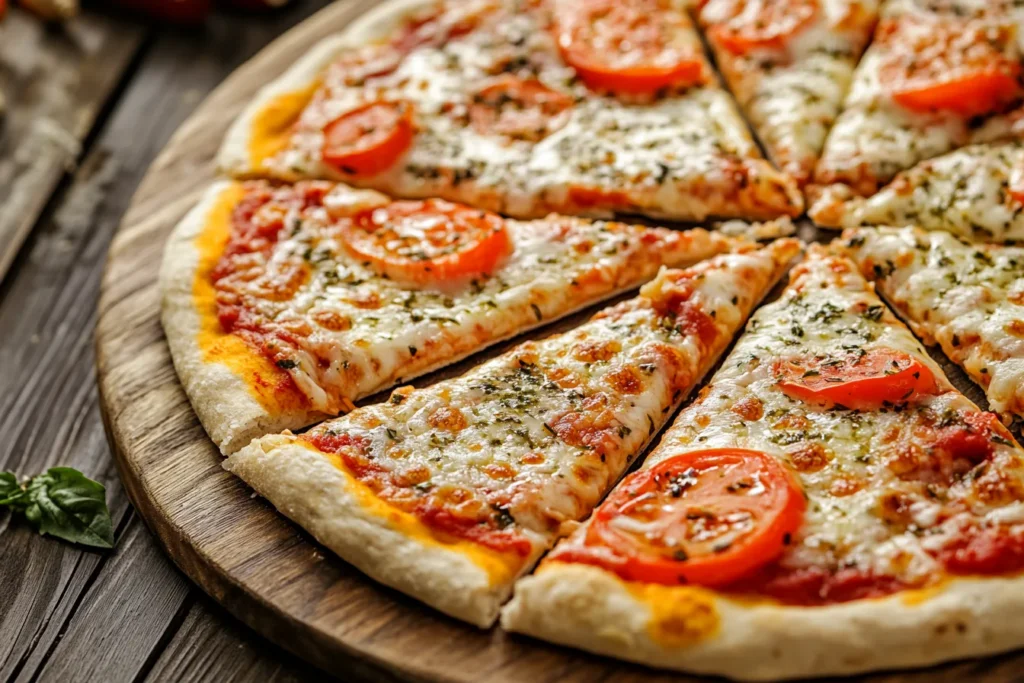Part 1: Understanding the Basics of Homemade Pizza
H1: Introduction to Homemade Pizza
There’s nothing quite as satisfying as creating your own pizza masterpiece from scratch. Homemade pizza is more than just a meal—it’s an experience that allows for creativity, personalization, and quality control. When it comes to elevating your pizza game, Gordon Ramsay’s style offers a blend of traditional Italian techniques with modern twists.
What sets Gordon Ramsay’s method apart is his emphasis on simplicity, fresh ingredients, and refined techniques. Whether you’re aiming for a crispy crust or perfectly balanced toppings, Ramsay’s approach ensures each slice is a culinary delight. His philosophy? Start with quality basics, and let the ingredients shine.
H2: Essential Ingredients for Gordon Ramsay’s Pizza
A great pizza starts with great ingredients. Ramsay emphasizes using the freshest components to bring out maximum flavor. Here’s a breakdown of what you’ll need:
- Basic Dough Ingredients:
- All-purpose or ’00’ flour
- Yeast (active dry or instant)
- Warm water
- Olive oil
- Sugar and salt for balance
- Sauce Components:
- Fresh tomatoes or high-quality canned tomatoes
- Garlic
- Basil leaves
- Olive oil
- A pinch of sugar
- Toppings Essentials:
- Fresh mozzarella or burrata
- High-quality meats like prosciutto
- Seasonal vegetables such as arugula, mushrooms, or bell peppers
- Optional: Truffle oil for an upscale touch

H3: The Perfect Dough: Ramsay’s Recipe
The foundation of any pizza lies in its dough. Ramsay’s recipe ensures a crust that’s both light and flavorful.
- Required Ingredients:
- 500g all-purpose flour
- 325ml warm water
- 7g active dry yeast
- 1 tbsp olive oil
- 1 tsp sugar and 1 tsp salt
- Step-by-Step Preparation:
- Combine yeast, warm water, and sugar in a bowl. Let it sit until frothy.
- Mix flour and salt in a large bowl, then slowly add the yeast mixture and olive oil.
- Knead the dough for 8-10 minutes until smooth.
- Cover and let it rise in a warm place for about an hour.
- Tips for Ideal Dough Texture:
- Use room temperature ingredients for uniform mixing.
- Knead thoroughly to develop gluten, ensuring elasticity.
- Allow the dough enough time to rest and rise—it’s worth the wait!
H4: Mastering the Pizza Sauce
The sauce ties the crust and toppings together. Ramsay’s method relies on simplicity and bold flavors.
- Fresh Tomato Base vs. Canned: Ramsay often prefers fresh, ripe tomatoes but suggests canned San Marzano tomatoes as a close alternative.
- Incorporating Herbs and Spices:
- Basil and oregano for aroma
- A pinch of chili flakes for heat
- Garlic sautéed in olive oil for depth
- Achieving Flavor Balance:
Simmer the sauce on low heat for 30 minutes, allowing the flavors to meld. Add a pinch of sugar to counteract acidity.
H5: Choosing the Right Toppings
Gordon Ramsay’s topping philosophy is all about balance—avoid overloading the pizza to let each ingredient stand out.
- Suggested Toppings:
- Proteins: Pancetta, prosciutto, or spicy sausage
- Vegetables: Roasted red peppers, artichokes, or mushrooms
- Cheeses: Mozzarella, parmesan, or a sprinkle of gorgonzola for extra zest
- Key Tips:
- Opt for seasonal and fresh produce for better flavor.
- Use toppings sparingly to avoid sogginess.
H6: Necessary Kitchen Tools and Equipment
Having the right tools makes pizza-making more efficient and enjoyable. Ramsay recommends:
- Must-Have Tools:
- A large mixing bowl for dough preparation
- Rolling pin or hands for shaping the dough
- A pizza stone or baking sheet
- Optional Gadgets:
- Pizza peel for easy oven transfer
- Dough scraper for clean handling
- Infrared thermometer to check oven temperature
H7: Prepping the Oven: Ramsay’s Tips
An exceptional crust depends on achieving the right oven setup.
- Using a Conventional Oven vs. Pizza Stone:
Ramsay suggests preheating a pizza stone in the oven at 250°C (482°F) to mimic a professional pizza oven’s heat. - Achieving Optimal Temperature:
Always preheat the oven for at least 30 minutes before baking to ensure even heat distribution.
H8: History of Gordon Ramsay’s Pizza Recipe
Ramsay’s love for Italian cuisine shines through his pizza recipes, which draw inspiration from traditional Neapolitan techniques. His recipes blend authentic methods with a modern touch, making them accessible to home cooks.
H9: Nutrition Overview
One of the benefits of making pizza at home is its nutritional control.
- Healthier Alternatives in Ramsay’s Method:
- Use whole-grain flour for added fiber.
- Swap full-fat cheese for low-fat options.
- Include plenty of vegetables as toppings for a balanced meal.
H10: Troubleshooting Common Dough Issues
Encountering dough issues is common, but Ramsay’s advice can help:
- Sticky Dough: Add a sprinkle of flour while kneading.
- Dough That Doesn’t Rise: Ensure yeast is fresh and water is warm, not hot.
- Dry Dough: Incorporate more water gradually during mixing.
Part 2: Step-by-Step Guide to Making Gordon Ramsay’s Homemade Pizza
H1: Preparing the Dough
Creating the perfect dough is the foundation of any great pizza. Gordon Ramsay’s method is foolproof, emphasizing patience and precision.
- Combining Ingredients:
- Begin by activating the yeast. Combine warm water, sugar, and yeast in a small bowl. Let it rest for 5-10 minutes until frothy.
- In a larger bowl, mix the flour and salt. Gradually add the yeast mixture and olive oil while stirring.
- Kneading Techniques:
- Knead the dough on a floured surface for at least 8 minutes.
- Use the “push and fold” method for consistency.
- Avoid over-kneading, as this can lead to a tough crust.
- Resting and Proofing Tips:
Cover the dough with a damp cloth and let it rise for an hour in a warm, draft-free space. The dough should double in size.
H2: Making the Signature Pizza Sauce
Ramsay’s pizza sauce is simple yet bursting with flavor. The key lies in the ingredients and the preparation.
- Preparing Ingredients:
- 6-8 ripe tomatoes (or a can of San Marzano tomatoes)
- 2 garlic cloves, minced
- Olive oil
- Fresh basil leaves
- A pinch of chili flakes
- Cooking and Reducing the Sauce:
- Heat olive oil in a pan and sauté garlic until fragrant.
- Add chopped tomatoes and let them simmer for 20-30 minutes.
- Stir occasionally, allowing the sauce to thicken.
- Ramsay’s Flavoring Techniques:
- Add fresh basil and a pinch of chili flakes at the end of cooking.
- Adjust seasoning with salt, pepper, and a touch of sugar for balance.

H3: Stretching and Shaping the Dough
Once the dough has proofed, it’s time to shape it into the perfect base.
- Achieving the Perfect Pizza Base:
- Roll the dough onto a lightly floured surface or stretch it by hand.
- Aim for a thin, even layer with a slightly thicker edge for the crust.
- Avoiding Tears in the Dough:
- Handle the dough gently to prevent tearing.
- If a tear occurs, pinch it back together.
- Tips for Even Thickness:
Use a rolling pin or stretch the dough gradually, rotating it frequently to maintain uniformity.
H4: Assembling the Pizza
Layering is crucial to avoid a soggy base and ensure every bite is balanced.
- Layering the Sauce:
Spread a thin, even layer of sauce across the dough, leaving about an inch at the edges for the crust. - Properly Distributing Toppings:
- Start with a layer of cheese (mozzarella is ideal).
- Add vegetables and meats sparingly to avoid overcrowding.
- Finishing with Cheese and Seasonings:
- Sprinkle grated parmesan or a dash of oregano for added depth.
- Add a drizzle of olive oil before baking for a glossy finish.
H5: Baking Like a Pro
Baking is where your pizza transforms from dough and toppings into a masterpiece.
- Preheating the Oven for Optimal Results:
Ramsay recommends preheating your oven to 250°C (482°F) with a pizza stone inside. This ensures a crispy base. - Monitoring the Baking Process:
- Bake the pizza for 7-10 minutes, depending on thickness.
- Keep an eye on the crust—it should turn golden brown.
- Achieving the Perfect Crust Texture:
If using a pizza stone, allow the pizza to cook directly on it. For extra crispiness, switch to the broil setting for the last minute.
H6: Garnishing and Finishing Touches
The finishing touches elevate your pizza from good to gourmet.
- Adding Fresh Herbs and Olive Oil:
- Sprinkle freshly chopped basil or arugula right after baking.
- A drizzle of high-quality olive oil enhances the aroma and flavor.
- Presentation Tips for Serving:
Slice the pizza into even wedges and serve it hot on a wooden board for an authentic touch.
H7: Crafting a Ramsay-Style Gourmet Pizza
Experimentation is encouraged when crafting a gourmet pizza.
- Unique Toppings to Try:
- Fig and prosciutto with balsamic glaze
- Truffle oil with wild mushrooms
- Smoked salmon with crème fraîche
- Signature Flavor Combinations:
Ramsay often pairs salty and sweet flavors, such as gorgonzola with caramelized onions.
H8: Alternative Pizza Styles by Gordon Ramsay
For variety, try these Ramsay-approved pizza styles:
- Thin-Crust Pizza:
Roll the dough extra thin for a crispy, cracker-like crust. - Deep-Dish and Stuffed-Crust Variations:
Use a cast-iron skillet for a deep-dish pizza or fold cheese into the edges of the dough for a stuffed crust.
H9: Vegan and Gluten-Free Pizza Options
Ramsay’s recipe can be adapted to suit dietary preferences.
- Vegan Substitutes:
- Replace cheese with vegan mozzarella or nutritional yeast.
- Use vegetable-based toppings like roasted eggplant or zucchini.
- Gluten-Free Adaptations:
Substitute regular flour with a gluten-free blend. Add xanthan gum for elasticity.
H10: Pairing Beverages with Your Pizza
The right beverage enhances your pizza experience.
- Recommended Wines:
- A light Pinot Noir complements a classic margherita.
- For meat-based pizzas, opt for a bold Chianti.
- Refreshing Non-Alcoholic Options:
- Sparkling water with a splash of lemon
- Homemade iced tea with herbs like mint
Part 3: Advanced Tips, Variations, and Serving Ideas
H1: Secrets Behind Ramsay’s Flavor Enhancements
To elevate a homemade pizza to gourmet status, it’s all about the details. Gordon Ramsay’s flavor tricks ensure that every bite is unforgettable.
- Using High-Quality Olive Oil:
A drizzle of extra virgin olive oil adds richness and a subtle, fruity aroma to the pizza. Ramsay recommends choosing cold-pressed oils for their robust flavor. - Balancing Acidity and Sweetness:
The pizza sauce is a cornerstone of flavor. Adding a pinch of sugar balances the natural acidity of tomatoes, while a splash of balsamic vinegar adds complexity. - Layering Herbs and Spices:
Use fresh herbs like basil and oregano for a fragrant, aromatic finish. Ramsay also suggests a sprinkle of chili flakes for heat without overpowering the dish.
H2: Seasonal Toppings for Year-Round Enjoyment
One way to keep your homemade pizza fresh and exciting is to adapt your toppings based on the season.
- Summer Toppings:
- Grilled zucchini and bell peppers
- Fresh burrata cheese topped with arugula
- Slices of ripe heirloom tomatoes
- Winter Toppings:
- Roasted root vegetables like sweet potatoes and parsnips
- Caramelized onions and gorgonzola cheese
- Truffle oil paired with sautéed wild mushrooms
- Leveraging Local Produce:
Visit farmers’ markets to find seasonal ingredients that are fresh and flavorful.
H3: Creative Pizza Crust Variations
The crust doesn’t have to be plain—Ramsay encourages experimenting with creative options.
- Stuffed Crust Techniques:
Roll the dough edges over mozzarella sticks or ricotta cheese for a gooey, indulgent crust. - Herb-Infused Crusts:
Knead chopped rosemary, thyme, or garlic powder into the dough to add a burst of flavor with every bite. - Alternative Bases:
For a low-carb option, try a cauliflower crust or a chickpea-based dough.
H4: Making Pizza with Kids
Cooking with children can be a fun and interactive way to spend time together while fostering creativity in the kitchen.
- Fun, Safe, and Interactive Tips:
- Let kids shape their own mini pizzas using smaller portions of dough.
- Offer a variety of pre-chopped toppings for them to choose from.
- Kid-Friendly Topping Ideas:
- Classic combinations like pepperoni and cheese
- Sweet options like Nutella and banana for a dessert pizza
Make the experience more engaging by turning it into a pizza-making competition or themed party.
H5: Storing and Reheating Leftover Pizza
Properly storing and reheating leftover pizza ensures it retains its flavor and texture.
- Best Practices for Refrigeration:
- Store slices in an airtight container or wrap them in foil.
- Keep pizza in the refrigerator for up to 3 days.
- Reviving Leftovers for a Fresh Taste:
- Reheat in a skillet over medium heat to restore the crust’s crispiness.
- Add a few drops of water to the pan and cover with a lid for a steamed effect that melts the cheese.

H6: Hosting a Homemade Pizza Night
Turn pizza-making into a social event with friends or family.
- Setting Up a DIY Pizza Bar:
- Prepare individual dough portions for guests to shape.
- Provide a variety of sauces, cheeses, and toppings for customization.
- Entertainment and Serving Ideas:
- Pair pizza night with Italian-themed music and wine.
- Serve pizzas family-style for a communal dining experience.
H7: Mistakes to Avoid When Making Pizza
Even the best recipes can go wrong without proper execution. Here are common pitfalls and how to prevent them.
- Overloading the Pizza:
Too many toppings can weigh down the crust and cause uneven cooking. Stick to a maximum of 4-5 toppings. - Not Preheating the Oven:
Baking pizza in a cold oven results in a soggy crust. Always preheat for at least 30 minutes. - Skipping Dough Resting Time:
Rushing the dough leads to a dense and chewy base. Allow enough time for it to rise and relax.
H8: Comparing Homemade Pizza to Restaurant Pizza
Homemade pizza has distinct advantages over its restaurant counterpart.
- Cost Savings and Taste Comparisons:
Making pizza at home is significantly cheaper, especially when feeding a crowd. Additionally, you have complete control over the ingredients, ensuring fresher flavors. - Why Homemade is Healthier:
- Use less oil and salt.
- Incorporate whole-grain flours or veggie-based crusts.
- Opt for lean proteins and fresh produce.
H9: Expanding Beyond Traditional Pizzas
Pizza doesn’t have to be confined to savory toppings—get creative with alternative styles.
- Dessert Pizzas:
- Spread Nutella or mascarpone cheese on a baked crust.
- Add fresh fruits like strawberries or sliced bananas.
- Fusion-Style Creations:
- Thai-inspired pizza with peanut sauce, chicken, and cilantro.
- Mexican pizza topped with salsa, beans, and guacamole.
H10: Frequently Asked Questions About Ramsay’s Pizza Recipe
- Can I make the dough in advance?
Yes, the dough can be stored in the refrigerator for up to 24 hours or frozen for later use. - How do I prevent my pizza from sticking to the stone?
Sprinkle the stone with cornmeal or flour before placing the dough on it. - What’s the best cheese to use for pizza?
Fresh mozzarella is ideal, but you can also use provolone or a mix of cheeses for variety. - Do I need a pizza oven to make great pizza?
No, a regular oven with a pizza stone or steel works perfectly for homemade pizza. - How thin should I roll the dough?
For a classic crust, aim for 1/4 inch thick. For thin-crust pizza, roll it even thinner. - Can I make pizza without yeast?
Yes, you can use baking powder or Greek yogurt-based dough as alternatives. - Why does my pizza dough tear when I stretch it?
Over-kneading or insufficient resting can make the dough too tight. Let it relax for a few minutes. - What’s the secret to a crispy crust?
High oven temperature and preheating your pizza stone are key. - Can I use pre-made sauce for convenience?
Yes, but enhancing it with fresh herbs and spices can elevate the flavor. - What’s the best way to cut pizza?
Use a sharp pizza cutter or a rocking pizza knife for clean, even slices.

